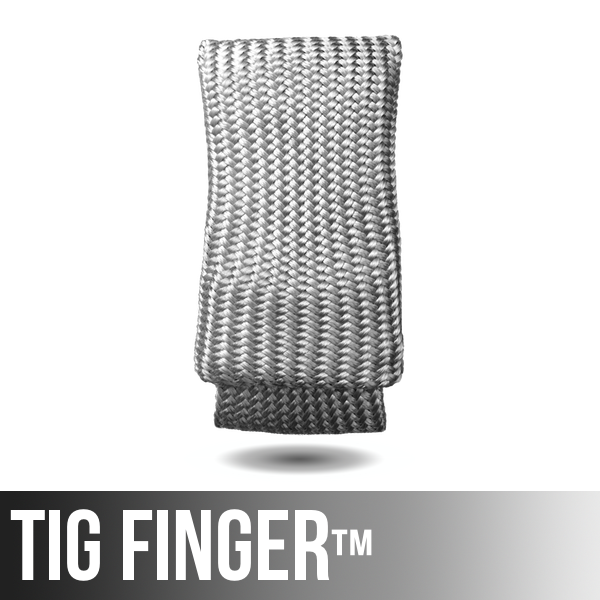Video Transcript:
AC Frequency Settings: TIG Welding Aluminum
I’m TIG welding aluminum today, and I’m comparing AC frequency. I’m gonna compare 50 hertz to 250 hertz. I’ve got some aluminum tubing, some eight-inch aluminum tubing, O-70 wall. It’s a bit less, a little bit less than two millimeters thick. I’m gonna set it up on a positioner and I’m gonna compare penetration, same amperage, 50 hertz, 250 hertz. Let’s do it.
I’m using some [dynaflux 00:00:38] aluminum spray cleaner and some Scotch Brite to get this stuff nice and clean before I weld it. I’m gonna put a few lines on it using a wraparound and a scribe. Then I’m gonna set the speed of the positioner, and the way that I do that is just a down and dirty piece of tape like this, and I put one-eighth inch increments on there, and then I just kind of count, “Thousand one, thousand two, thousand three,” one-eighth of an inch per second will get me in the ballpark every time. Sometimes I need to go a little faster, sometimes a little slower. But that gets me in the ballpark.
This machine will go from 20 to 250 hertz on AC frequency. I’m gonna leave the AC balance alone and set the frequency to 50 hertz for the first run. You can hear the low buzz there.
That is penetrating all the way through. You can kind of watch, if you really watch, you can see the puddle kind of sink every time I dab rob. And then you can watch the back side of it here. I’ve got a camera pointed up in there. And it’s set at 90 amps. Again, the material thickness is about 70 thousandths, a little less than two millimeters. And that’s enough to get pretty consistent penetration. And so at 50 hertz, it is getting consistent penetration.
All right, keep an eye on this little scratch here. I’m gonna show that again in a little bit, sort of a little magnified. I’m gonna show the penetration side again as I heat the metal up here when I first light up on it. It takes it a second, ’cause everything’s cooled off and there’s a little bit of a massive weld in the crater. And there it’s molten now, and there I’m moving along, and I’m gonna pass over that scratch, and we see it just pushes it on down, like it was some sort of peel coat or something.
Also, you notice that there’s a little bit of orange tint right there at the front of the puddle. Aluminum doesn’t change color when it gets hot, but that is the arc trying to kind of shine through the puddle a little bit.
All right, did you see that? Did you see that? That was pretty crazy. That scratch, if that was steel or stainless steel, when the molten puddle passed through that, it would have completely consumed the scratch and melted it, and this didn’t. It just pushed it on down like it was a peel coat layer or something. That’s interesting. What can we learn from that? I don’t know yet. Let’s keep going.
Let’s crank it up to 250 hertz here, all the way max frequency. Not gonna change anything else. And we’ll see what happens.
Well, the noise changed, that’s for sure. We’ve got a much more annoying sound to put up with, but there are the beads narrowing up, but it’s not penetrating. It’s just laying up there on the surface. I’ll show the back side of it here in just a second. But you know, aside from the difference in the sound, if I were to increase the amperage here, I’m sure I could penetrate with a good 10 or 15 more amps. But it’s not penetrating at all. You notice on the left side there, you’ll notice a little hazy area underneath the penetration that did happen previously. That little hazy area is just not even nipping through.
So there’s the two beads, 250 hertz, 50 hertz.
And here’s the penetration on the 50 hertz. And there’s the no penetration on the 250 hertz.
Okay, so we saw that 50 hertz got more penetration than 250 hertz. It’s like 250 hertz didn’t get any. So we sacrificed something. There was some energy lost somewhere when I increased the frequency to 250 hertz. Well, how does that help to know that? Well, I’m welding with a 200-amp machine today. A lot of people have 200-amp machines, and sometimes you get an aluminum job comes through, and it’s right at the top of what that machine can do. If you know that you’ll get more heat input by dropping the frequency, on those particular jobs, that’s all your machine can handle, you’re gonna be better off dropping that frequency to 50, maybe even 40, put some more heat into that part and save those high-frequency applications for thin stuff or where you really want to pinpoint heat and get a real narrow aluminum bead.
A lot of times, to be honest, a lot of times the frequency either only matters a little bit or doesn’t matter at all. You can compensate in other ways. So I’m just trying to add to the conversation here. I’m learning every day, and I hope you are too. We’ll see you next time.
If you’ll hang around for few more seconds, I’ve got a quick product video of the stubby gas lens kit that I used in this video. Standard cups like this work just fine until you have to extend the electrode out past about maybe three-eighths of an inch. Here I’ve got it extended seven-sixteenths of an inch at 20 CFH. That’s just a little bit farther than it wants to handle. Things are ropy, it’s oxidized, it’s graying up, and that’s really not what you want to see on stainless steel. It kind of takes the fun out of welding. And also, it could be a problem on the corrosion resistance.
So now I’m gonna swap out the standard cup here to a stubby gas lens, still a number six, and I’m gonna extend the electrode out a good half inch and we’ll see how that does. Much better. That’s more like what you want to see. Of course it always helps to keep the hot tip of that filler rod shielded with the argon. But if you have a 17, 18 or 26-style torch, and you like the idea of shrinking the overall size of it and getting good gas coverage and being able to extend your electrode, you can learn more at WeldMonger.com. Thanks for watching. We’ll see you next time.







Leave a Reply